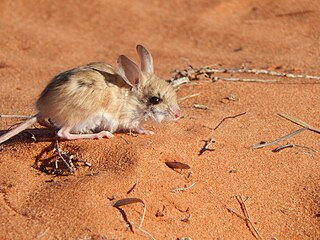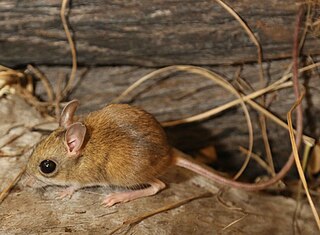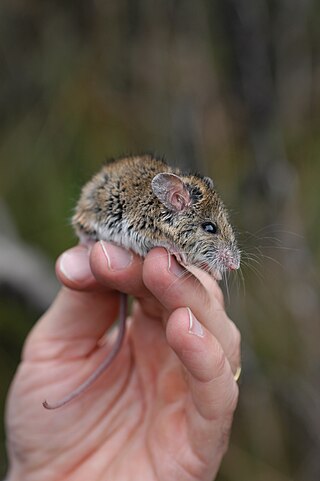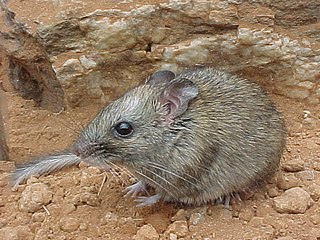
A hopping mouse is any of about ten different Australian native mice in the genus Notomys. They are rodents, not marsupials, and their ancestors are thought to have arrived from Asia about 5 million years ago.

The dusky hopping mouse, is a small rodent endemic to Australia, inhabiting desert regions characterised by sand dunes. Populations have experienced significant declines since the arrival of Europeans, and continue to be subject to threatening processes. It is currently listed as a threatened species.

The spinifex hopping mouse, also known as the tarkawara or tarrkawarra, occurs throughout the central and western Australian arid zones, occupying both spinifex-covered sand flats and stabilised sand dunes, and loamy mulga and melaleuca flats.
The big-eared hopping mouse is an extinct species of mouse, which lived in the Moore River area of south-western Australia. The big-eared hopping mouse was a small, rat-sized animal resembling a tiny kangaroo. It had large eyes and ears with a brush-tipped tail. It moved on its four legs when traveling at a slower pace, or by bounding upon its enlarged, padded, hind feet when traveling quickly. They mainly lived in sand dunes and made nests of leaves and other organic materials. The big-eared hopping-mouse was last collected in July 1843 near the Moore River, Western Australia, close to where New Norcia is now situated, and has not been seen since.

Mitchell's hopping mouse also known as the pankot, is the largest extant member of the genus Notomys, weighing between 40 and 60 g. N. mitchellii is a bipedal rodent with large back legs, similar to a jerboa or kangaroo rat. The species occurs throughout much of semi-arid Southern Australia, and appears to be particularly common on the Eyre Peninsula, South Australia. Typical habitat for N. mitchellii appears to be mallee shrublands on sandy dune systems. The species is currently considered to be unthreatened, but its range has been reduced through habitat disturbance and destruction associated with European settlement in Australia.
The Arizona pocket mouse is a rodent native to the Sonoran desert. It is a small mouse with a thinly furred tail that is smooth from base to tip. In color it ranges from tan to orange. It is a nocturnal, burrowing animal. It eats seeds, which it carries back to its burrow in its cheek pouches.

The plains rat(Pseudomys australis), also known as the palyoora, plains mouse and eastern mouse, is a conilurine rodent native to arid and semi-arid Australia. Referred to as the pallyoora or yarlie by Indigenous groups, the plains rat was once widely distributed across central Australia, including north-west New South Wales and south-west Queensland; however, habitat degradation due to grazing, introduced predators and drought have contributed to its decline. Consequently, the plains rat has been listed as 'presumed extinct' in New South Wales and Victoria, 'endangered' in the Northern Territory and Queensland and 'vulnerable' in Western Australia and South Australia. While recent research has indicated the presence of the plains rat in areas such as the Fowlers Gap and Strzelecki Desert regions of New South Wales and within the Diamantina National Park in Queensland, there are only five sub-populations currently recognised nationally, none of which coincide with recent discoveries of the plains rat. As the current population trend of the plains rat has been listed as 'declining' by the International Union for the Conservation of Nature (IUCN), the IUCN conservation status for the species is 'vulnerable'.

The northern hopping mouse is a species of rodent in the family Muridae. It is found only in coastal northern Australia, from Arnhem Land to the Cobourg Peninsula.

The long-tailed hopping mouse is an extinct species of rodent in the family Muridae. It was found only in Australia. It is known from a handful of specimens, the last of which was collected in 1901 or possibly 1902. It is presumed to have become extinct within a few decades from then – possibly several decades in view of a skull fragment found in an owl pellet in 1977. The cause of extinction is unknown, but may be a variety of factors including predation and habitat alteration. Little is known of its biology other than that it dug burrows in stiff clay soils. It was less a pest to humans than other hopping mice, although it would eat raisins. The mouse was mainly gray in colour with small pink ears and big eyes with a long hairy pink tail about two inches longer than its own body. It was first described by John Gould on the basis of specimens sent to him from Australia.
The Darling Downs hopping mouse is an extinct species of mammal in the family Muridae. It is known from a single skull found at Darling Downs, Queensland, Australia. Introduced predators such as foxes and domestic cats may have forced this species into extinction. The skull is identified as one of the Notomys, the hopping mice, an Australian genus that has been subject to rapid declines in populations leading to local and species extinction.

The New Holland mouse also known as a Pookila is a species of rodent in the family Muridae. It was first described by George Waterhouse in 1843. It vanished from view for over a century before its rediscovery in Ku-ring-gai Chase National Park north of Sydney in 1967. It is found only in south east Australia, within the states of New South Wales, Queensland, Victoria, and Tasmania.

The central rock rat, also known as the central thick-tailed rock-rat, Macdonnell Range rock-rat, and Australian native mouse, is a critically endangered species of rodent in the family Muridae endemic to Australia.

The San Diego pocket mouse is a rodent species in the family Heteromyidae. It occupies the northern region of Baja California near San Diego extending into Mexico.
The great hopping mouse is an extinct species of mammal native to Australia. It is known only from skulls found in owl pellets in the Flinders Ranges. Some pellets also include bones of the introduced house mouse—indicating that it survived into historic times, possibly the second half of the 19th century. From the skull, it appears to have been relatively large and to have escaped collection by early 19th century naturalists by chance. From the location of the deposits it is assumed that it preferred clay rather than sandy soils. It is also commonly known as the broad-cheeked hopping mouse.

The fawn hopping mouse is a medium sized rodent endemic to the Channel Country Bioregion of northeast South Australia and southwest Queensland in Australia. They inhabit open gibber (stony) and clay plains of the Lake Eyre basin. While the population and distribution has been greatly reduced since European settlement, the current population shows little evidence of significant decline and is consequently listed as 'Near Threatened'.

Hydromyini is a very large, diverse tribe of muroid rodents in the subfamily Murinae. They are the dominant native rodents in Australasia and one of only two native rodent groups there, the other being the R. fuscipes group of the genus Rattus in the tribe Rattini. They are also found in parts of Southeast Asia.













